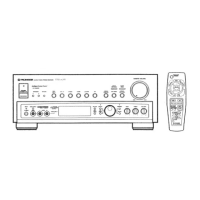
Do you have a question about the Pioneer VSX-605S and is the answer not in the manual?
| Type | Stereo Receiver |
|---|---|
| Channels | 2 |
| Input Sensitivity | 200 mV (Line) |
| Speaker Load Impedance | 6 - 16 Ohms |
| Digital Inputs | Coaxial, Optical |
| Video Inputs | Composite, S-Video |
| Video Outputs | Composite, S-Video |
| Weight | 10.5 kg |
| Power Output | 100 Watts per channel (8 Ohms, 20 Hz - 20 kHz, 0.09% THD) |
| Frequency Response | 5 Hz to 100 kHz |
| Frequency Response (alternative) | 5Hz-100kHz (Direct mode) |
| Total Harmonic Distortion | 0.09% (at rated power) |
| Total Harmonic Distortion (alternative) | 0.1% (20 Hz to 20 kHz, 8 ohms) |
| Dimensions | 420 x 158 x 416 mm |
| Dimensions (alternative) | 16.5 x 6.2 x 16.4 inches |
Important notices for U.S. and Canadian models regarding serial numbers and safety.
Describes key operational features like DEMO, RETURN, and RESET functions.
Comprehensive safety instructions covering usage, installation, and maintenance of the appliance.
Specific instructions for grounding outdoor antennas for safety and performance.
Instructions for setting voltage selectors and PAL/NTSC switches on multi-voltage models.
Details on setting the channel step switch for regional frequency allocations.
Explains STUDIO, SIMULATED SURROUND, and ARENA modes for sound enhancement.
Details DOLBY PRO LOGIC SURROUND and DOLBY 3CH LOGIC functions for enhanced audio.
Options for center speaker modes (NORMAL, WIDE) and non-speaker mode (PHANTOM).
Recommendations for optimal placement of front, center, and rear speakers.
Instructions for setting up the AM antenna and power cord safety precautions.
Important precautions regarding unit installation and ventilation.
How to connect FM/AM antennas and various audio components like turntables, CD players.
Instructions for connecting to a Pioneer projection monitor receiver as a center speaker.
How to connect TV, VCR, and LD/DVD players for video input/output and playback.
How to connect front, center, and rear speakers, including impedance notes.
Instructions for installing and using MAIN-REPEATER and MINI-REPEATER for remote control.
Description of antenna terminals, system control jacks, and video/audio jacks.
Details on various audio/video jacks and speaker terminals, including impedance.
Information on the switched AC outlet and power cord safety precautions.
Location and function of remote sensor, power switch, and speaker system buttons.
Functions of the RETURN button and input selector buttons for choosing audio sources.
Describes SFC MODE, DOLBY, SUPER BASS, BASS/TREBLE/BALANCE, and tuner/input selector buttons.
Covers PHONES jack, VIDEO INPUT, RESET, GUI MODE, and Multi-jog controls.
Explains the meaning of various indicator lights on the display section.
Describes the character display for showing information like station names or settings.
How to manually tune and preset FM/AM radio stations.
Using preset tuning, last station memory, and receiving FM simulcast TV programs.
Guide to selecting program sources and playing back audio/video components.
Steps for recording to cassette decks, including VCR/TAPE 1 and TAPE 2.
How to record video sources to VCR and perform LD/DVD to VCR dubbing.
How to select and adjust surround modes using specific buttons.
Recommendations for FM/AM antenna setup and grounding for improved reception.
Step-by-step guide for battery installation and information on remote operating range.
Guidance on when to replace batteries and important usage guidelines.
Explains buttons on the remote for controlling the receiver itself, including GUI and One Touch.
How to control external components like TV, VCR, LD/DVD, SAT, and Tuner using the unit's remote.
How to operate various components like TV, VCR, LD/DVD, SAT, and Tuner using the remote.
Introduction to GUI and explanation of GUI-specific receiver control buttons.
How to use the tuner display, tune stations, and set presets within the GUI interface.
How to control VCR/LD/DVD and manage CD disc titles using the GUI.
Detailed steps for inputting and registering disc titles for CD players.
Step-by-step guide for dubbing LD/DVD to VCR using the GUI interface.
How to adjust the delay time for surround sound modes.
Steps to adjust center and rear speaker levels using test tones.
Procedures for calling up and setting up presets for other manufacturers' components.
Steps for teaching the unit remote control signals from other components.
How to set up operation signals for ONE TOUCH OPERATION buttons.
Solutions for problems like no power, no sound, no picture, or control malfunctions.
Troubleshooting steps for high noise levels and reception problems.
Solutions for no auto stop, no TV source, no rear sound, and remote control problems.
Technical specifications for amplifier and tuner sections, including power, sensitivity, and frequency response.
Other specifications like video section, power requirements, dimensions, weight, and furnished parts.
Guidance on setting safe listening levels to protect hearing.
Instructions for cleaning the unit's exterior surfaces safely.
